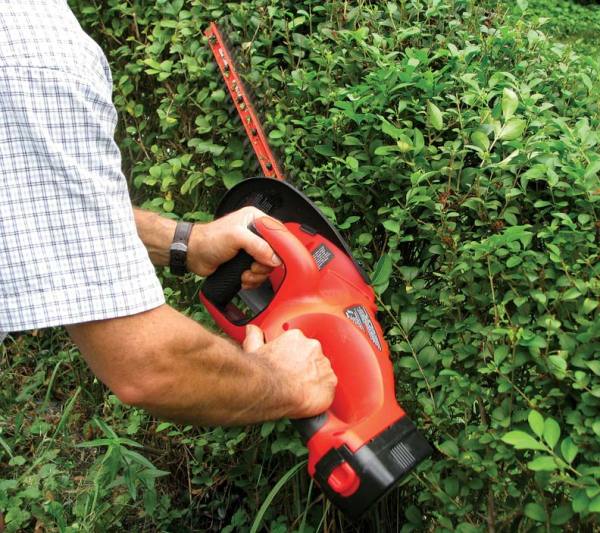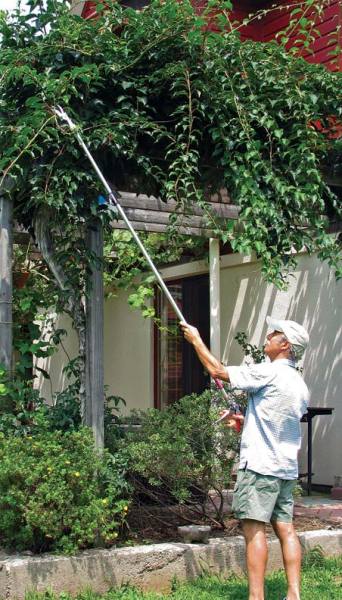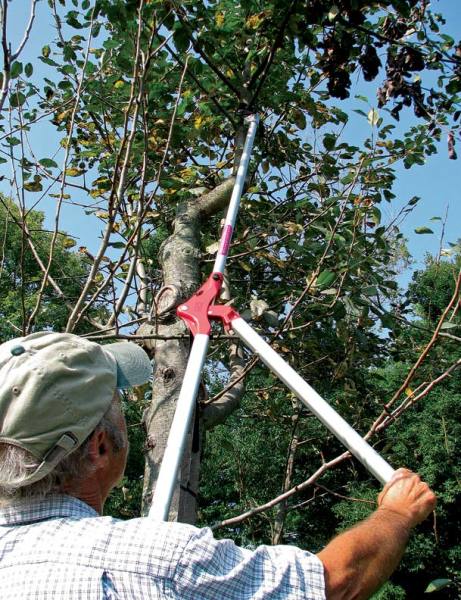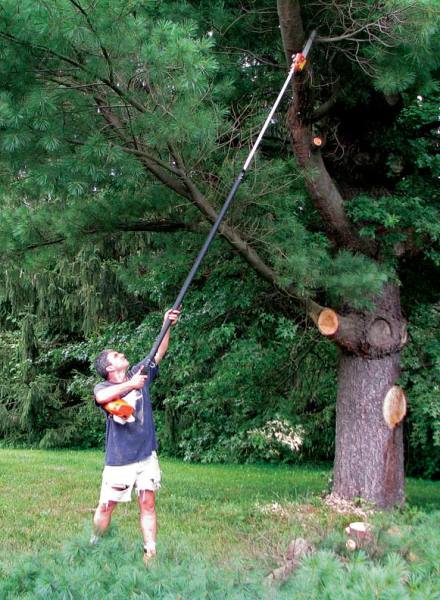Electric tools like a cordless trimmer make easy work of overgrown shrubs and trees.
Trees, shrubs, and vines are what give a home landscape an enduring quality. But these woody plants need occasional—and in some cases more than occasional—pruning.
Pruning helps young plants develop strong, attractive form; when they’re older, it helps maintain their beauty and stave off decrepitude that comes from a buildup of dead wood and disease. Decades and centuries ago, such work was entrusted to gardeners, who were both knowledgeable and affordable. Knowledge is still indispensable, but today’s tools make most pruning jobs easily tackled by homeowners.
Hedge Your Bets
Take, for instance, a long, tall, stately hedge that separates an outdoor space into garden “rooms.” In the past, trimming this hedge would have meant climbing a ladder with hand hedge shears (essentially giant scissors) in tow. Today, pole hedge shears make this job easier and less dangerous. With feet firmly planted on the ground, you can reach heights of 10′ or more to trim a wall of greenery, and the pole trimmer’s articulating head lets you trim the top flat or at any other angle.
For years, I’ve used a Remington Extended Reach Electric Hedge Trimmer to maintain a tall crabapple hedge that frames the garden view out the back door of my barn. But this tool is heavy, and it relies on a power cord, so recently I’ve had my eye on the Black & Decker Pole Hedge Trimmer.
Long-reach shears make ladders obsolete for maintaining high vines.
Its 20-volt battery lets it shed the power cord (with some sacrifice of power). Another option is the Echo gasoline-powered pole hedge shear, which packs plenty of power and has its weight more comfortably distributed at the bottom of the handle—but its price and noise level are significantly higher than other shears.
No pole is needed, of course, for shearing low hedges. Once again, these tools run the gamut between hand, corded and cordless electric, and gasoline-powered. Convenience counts for any hedge, large or small, because repeated shearing—three times or more throughout the growing season, depending on the plant and the climate—is needed to force new, densely branching growth.
You’ll know hedges need trimming when they start to look scraggly—similarly to when you decide you need a haircut. After a few years, a hedge tends to get larger or out of shape—then it’s time for a more drastic cutting back into older wood, followed by periodic shearing (begun before the “new” hedge is full-size) to help new growth fill in densely.
Shrub Solutions
For trees or informal shrubs, such as lilacs, forsythias, and mockoranges, the goals are opposite of those for sheared hedges—in this case, you need to make fewer cuts into older wood. Occasional shortening of some stems and lopping off of others keeps trees invigorated and shapely. Less pruning is needed as a tree ages, except for many kinds of fruit trees. (Click here for more on pruning fruit trees.)
With shrubs, you want to cut down older stems to make way for younger ones, although if the younger ones are coming up too densely, you’ll also need to remove some of these so those that remain have sufficient room to develop. Modern hand shears (what the Brits call secateurs), loppers, and saws make these jobs easier.
A long-reach lopper is ideal for small, high branches.
Because a pair of hand shears is such a useful tool—one I often drop into my back pocket before I walk out into the garden—it pays to check out the style, weight, hand fit, and balance of several models to ensure the most comfortable fit. Some modern innovations include shears that are adjustable to hand size or have rotating grips to ease hand strain. (The rotation feels odd to me, but that’s a personal preference.)
Shears with ratcheting action make it easier to slice through thicker stems, although the handle does need to be squeezed together repeatedly. A small but potentially bothersome feature is the locking mechanism, which can require two hands to lock or unlock; I like the way my ARS shears unlock with a mere squeeze of the handles.
For pruning branches larger than ½” across and up to about 1½” in diameter, you need lopping shears, usually just called loppers. This tool is essentially the same as hand shears, except the blades are beefier, and the handle is a couple or more feet long. I like the Fiskars Powergear loppers; they combine the best of new materials and technology, with super-light handles and a gearing mechanism that packs more power into each cut to make the job easier.
That 1½”-thick branch could, of course, be sawn off instead; a saw is a must-have for larger-diameter branches. The most important part of a modern pruning saw is the blade, and today’s best blades are alternately referred to as turbo, Japanese, tri-edge, or three-angled. Each tooth on these blades has three bevels, which translates into fast, smooth cutting.
Larger-diameter branches require a saw; new pole-mounted saws are sturdier than previous models.
The traditional bow saw, comprised of a thin, sharp, inexpensive, and replaceable blade pulled taut between the ends of a similarly inexpensive bow of metal tubing, also makes fast and clean cuts. That bow, however, does keep this saw from getting into tight spaces.
Beyond the blade, what makes a pruning saw more or less desirable gets more personal. There are saws available with curved or straight blades, wooden or rubbery handles, in folding and non-folding designs. The smallest saws are compact and light enough to carry along on an early-season stroll through the yard for corrective cuts here and there on trees and shrubs, and even for more dramatic cuts on limbs 3″ or 4″ in diameter.
Tree Time
Even though trees generally require little pruning once mature, there is the occasional dead, broken, or misplaced branch that needs removal. For cutting individual branches higher up in a tree or bush, we’re back to poles. A good turbo blade on the end of a pole can reach 15′ up into a tree.
Modern technology has greatly improved pole saws; previous versions had either heavy wooden handles or fiberglass ones that tended to flex like fishing poles, making them difficult to control. The best modern pole pruners, such as those made by Silky and ARS, have smooth-sliding, quick-locking, lightweight, and relatively rigid poles made from aluminum with oval or square cross-sections.
Smaller, high-reaching branches that don’t warrant a saw also can be pruned with your feet planted on terra firma. Loppers and hand shears also come in pole equivalents in various effective designs. You don’t have to keep moving a ladder around, so your pruning jobs are easier and quicker.
Lee Reich is the author of several gardening books, including The Pruning Book (Taunton Press, 2011).







